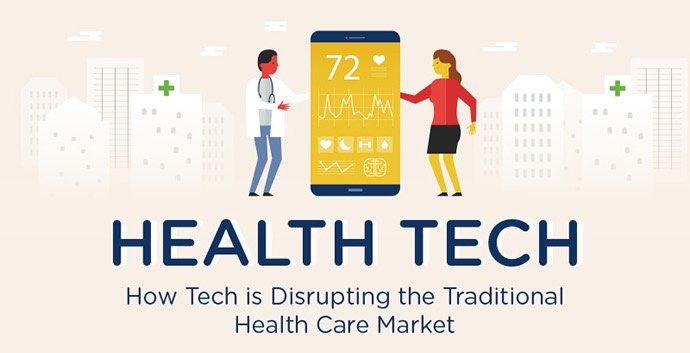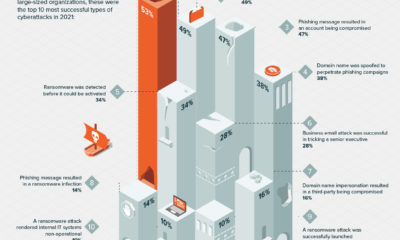The following infographic from MW Homecare shows how healthcare is being impacted by emerging technologies and startup companies.
Healthcare: the big picture
Today’s healthcare industry faces many hurdles that are driving up costs. Political and economic uncertainty, an aging population, and a growing prevalence of chronic diseases are all contributing factors in the global push to find more cost-effective healthcare solutions. The entire healthcare industry, from insurance providers to drug manufacturers, is seeking opportunities to reduce costs through modern technologies. This is playing into a wider trend towards a more personalized and efficient approach to healthcare. For investors, some of the most interesting crossroads between technology and healthcare may be found in big data, cybersecurity, developing markets, and strategic partnerships.
Big data
The collection and storage of large amounts of medical data, made possible by recent technological advancements, is helping healthcare professionals improve the quality of medical care, from research to diagnosis and treatment. Investor interest in digital health startups that use big data to improve the efficiency and effectiveness of healthcare is increasing. These companies attracted $5.8 billion in funding in 2015, according to CB Insights – an increase of 20% over the previous year.
Cybersecurity
While technology is disrupting the healthcare industry in many positive ways, it’s also creating new challenges that will need to be addressed with greater urgency moving forward. One issue is the world’s growing reliance on cloud-based technology, which can place personal medical data at risk of security breaches. Cyberattacks and IP theft are a growing threat to healthcare companies. According to Deloitte’s 2016 Global Life Sciences Outlook, in 2011 the U.K. government claimed that its life sciences and healthcare industry suffered $2.9 billion in losses due to IP theft. Investment into cybersecurity technology has grown by 235% over the last five years, reaching a total of $3.9 billion in 2015 alone, according to CB Insights.
Developing markets
Currently, each country has its own complex regulatory and compliance systems which act as gatekeepers in the development of medical products. While these systems are necessary in order to ensure the safety and credibility of products before they go to market, they often clash with technology’s rapid pace of innovation. Although the U.S. has been a leader in health tech innovation, current regulatory and compliance models tend to hold back progression. Digital health companies face heavy regulations in the U.S., which is causing investors to seek out new opportunities in developing markets such as China and India – two nations facing extreme healthcare costs against a backdrop of large aging populations and a rapid increase in chronic diseases such as cancer and diabetes. China, with more than 185 million residents currently over the age of 60, is set to become the world’s most aged society by 2030. The Chinese government has responded to this looming economic threat by opening up opportunities for private foreign investment into its healthcare sector. As part of China’s recently implemented 13th Five-Year Plan, foreign senior care operators are now permitted to set up wholly–foreign owned enterprises (WFOE) in China, and are eligible to receive tax incentives, administrative fee exemptions and deductions and waivers. Chinese health companies are also seeking opportunities in foreign health technologies that will help China meet its domestic healthcare needs.
Strategic Partnerships
A trend that has been occurring with more frequency in recent years is the establishment of partnerships between tech giants and healthcare startups. For example, by partnering with Epic Systems in 2014, Apple’s Healthkit platform was able to integrate substantial amounts of patient data to leverage its digital health and tracking technologies. Mergers and acquisitions within the digital health tech space have also been steadily growing over the last few years. In fact 2016 has been a record-breaking year for digital health tech M&A, with 41 deals in total – a solid increase over 2015’s total of 36 deals and 2014’s total of 33 deals. Many of these mergers and acquisitions are strategic moves by healthcare retail companies looking to build up their marketing presence and customer interaction platforms. As technology continues to act as a catalyst for rapidly changing market dynamics within the healthcare industry, it is likely that strategic partnerships, co-investments, and M&A will continue to be key drivers of growth.
on But fast forward to the end of last week, and SVB was shuttered by regulators after a panic-induced bank run. So, how exactly did this happen? We dig in below.
Road to a Bank Run
SVB and its customers generally thrived during the low interest rate era, but as rates rose, SVB found itself more exposed to risk than a typical bank. Even so, at the end of 2022, the bank’s balance sheet showed no cause for alarm.
As well, the bank was viewed positively in a number of places. Most Wall Street analyst ratings were overwhelmingly positive on the bank’s stock, and Forbes had just added the bank to its Financial All-Stars list. Outward signs of trouble emerged on Wednesday, March 8th, when SVB surprised investors with news that the bank needed to raise more than $2 billion to shore up its balance sheet. The reaction from prominent venture capitalists was not positive, with Coatue Management, Union Square Ventures, and Peter Thiel’s Founders Fund moving to limit exposure to the 40-year-old bank. The influence of these firms is believed to have added fuel to the fire, and a bank run ensued. Also influencing decision making was the fact that SVB had the highest percentage of uninsured domestic deposits of all big banks. These totaled nearly $152 billion, or about 97% of all deposits. By the end of the day, customers had tried to withdraw $42 billion in deposits.
What Triggered the SVB Collapse?
While the collapse of SVB took place over the course of 44 hours, its roots trace back to the early pandemic years. In 2021, U.S. venture capital-backed companies raised a record $330 billion—double the amount seen in 2020. At the time, interest rates were at rock-bottom levels to help buoy the economy. Matt Levine sums up the situation well: “When interest rates are low everywhere, a dollar in 20 years is about as good as a dollar today, so a startup whose business model is “we will lose money for a decade building artificial intelligence, and then rake in lots of money in the far future” sounds pretty good. When interest rates are higher, a dollar today is better than a dollar tomorrow, so investors want cash flows. When interest rates were low for a long time, and suddenly become high, all the money that was rushing to your customers is suddenly cut off.” Source: Pitchbook Why is this important? During this time, SVB received billions of dollars from these venture-backed clients. In one year alone, their deposits increased 100%. They took these funds and invested them in longer-term bonds. As a result, this created a dangerous trap as the company expected rates would remain low. During this time, SVB invested in bonds at the top of the market. As interest rates rose higher and bond prices declined, SVB started taking major losses on their long-term bond holdings.
Losses Fueling a Liquidity Crunch
When SVB reported its fourth quarter results in early 2023, Moody’s Investor Service, a credit rating agency took notice. In early March, it said that SVB was at high risk for a downgrade due to its significant unrealized losses. In response, SVB looked to sell $2 billion of its investments at a loss to help boost liquidity for its struggling balance sheet. Soon, more hedge funds and venture investors realized SVB could be on thin ice. Depositors withdrew funds in droves, spurring a liquidity squeeze and prompting California regulators and the FDIC to step in and shut down the bank.
What Happens Now?
While much of SVB’s activity was focused on the tech sector, the bank’s shocking collapse has rattled a financial sector that is already on edge.
The four biggest U.S. banks lost a combined $52 billion the day before the SVB collapse. On Friday, other banking stocks saw double-digit drops, including Signature Bank (-23%), First Republic (-15%), and Silvergate Capital (-11%).
Source: Morningstar Direct. *Represents March 9 data, trading halted on March 10.
When the dust settles, it’s hard to predict the ripple effects that will emerge from this dramatic event. For investors, the Secretary of the Treasury Janet Yellen announced confidence in the banking system remaining resilient, noting that regulators have the proper tools in response to the issue.
But others have seen trouble brewing as far back as 2020 (or earlier) when commercial banking assets were skyrocketing and banks were buying bonds when rates were low.

















